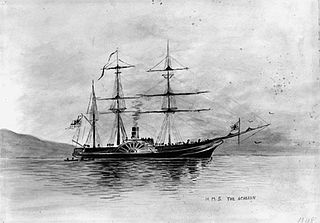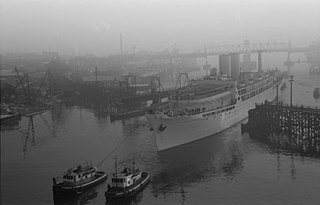Related Research Articles
HMS Enterprise was a 24-gun sixth-rate of the French Navy captured by HMS Triton on 7 May 1705. She was registered as a Royal Navy ship on 1 June 1705 and commissioned shortly afterwards. She served in the Mediterranean and with Admiral Byng's squadron at the Downs, She was wrecked in 1707 with the loss of all hands.
Thirteen vessels of the Royal Navy have borne the name HMS Mohawk, after the Mohawk, an indigenous tribe of North America:
Seven vessels of the British Royal Navy have been named HMS Bulldog, after the bulldog, with an eighth announced:
Ten ships of the Royal Navy have been named HMS Aetna or HMS Etna, after the volcano Etna:
Ten ships of the Royal Navy have been named HMS Scourge :
Nine ships and one shore establishment of the Royal Navy have been named HMS Wasp, with one other government vessel using the name:
Eleven ships of the Royal Navy have borne the name HMS Firebrand.
Twelve ships of the Royal Navy have borne the name HMS Mosquito, or the archaic HMS Musquito, after the tropical insect, the Mosquito:

HMS Port Quebec was a British motor ship that was designed and launched in 1939 to be the refrigerated cargo ship Port Quebec, but completed in 1940 as an auxuiliary minelayer. In 1944 she was converted into an aircraft component repair ship and renamed HMS Deer Sound. In 1947 she was returned to her owner, Port Line, and completed as a cargo ship. She was scrapped in Taiwan in 1968.

HMS Acheron was the last Hermes-class wooden paddle sloop ordered for the Royal Navy. She was launched at Sheerness in 1838. She spent two commissions in the Mediterranean before being reclassed as a survey ship in 1847. Between 1848 and 1851 she made a coastal survey of New Zealand, the first such survey since Captain Cook. She was paid off at Sydney and was tender to HMS Calliope. She was sold at Sydney in 1855.
HMS Swift has been the name of numerous ships of the Royal Navy:

The Speedy class brigs were a two-ship class of brig built for the Royal Navy during the later years of the American War of Independence. They survived into the French Revolutionary Wars.

HMS Venus was the name ship of the 36-gun Venus-class fifth-rate frigates of the Royal Navy. She was launched in 1758 and served for more than half a century until 1809. She was reduced from 36 to 32 guns in 1792. She was sold in 1822.
Three, and possibly five, vessels of the Royal Navy have borne the name HMS Sultana, for a female sultan or wife of a sultan:

HMS Agamemnon was originally the Blue Funnel Line refrigerated cargo ship Agamemnon. She was built in 1929, traded between the UK and the Far East, and was scrapped in 1963. During the Second World War she was converted into an auxiliary minelayer in 1940, and then into an amenities ship in 1943.

HMS Menestheus was originally the Blue Funnel Line refrigerated cargo ship Menestheus. She was built in 1929, and traded between the UK and the Far East. She was an auxiliary minelayer from 1940 to 1943. When the Second World War in 1945, she was undergoing conversion into an amenities ship. She was scrapped in 1953 after being gutted by fire.

HMS Southern Prince was a motor ship that was built in 1929 as the refrigerated cargo ship Southern Prince. She was commissioned into the Royal Navy in 1940 as a minelayer. She became a headquarters ship and then an accommodation ship in 1944, was a fleet training ship in 1945, and returned to civilian trade in 1946. In 1947 she was sold to Italian owners who had her refitted as a passenger ship and renamed her Anna C. From 1952 she was a cruise ship. She was scrapped in 1972.
Several ships of the Royal Navy have borne the name Hearty -

HMS Dee was the first paddle steamer ordered for the Royal Navy, designed to carry a significant armament. She was ordered on 4 April 1827 from Woolwich Dockyard. She was designed by Sir Robert Seppings, Surveyor of the Navy and modified by Oliver Lang. This vessel was considered as new construction as a previous vessel ordered as a flush deck Cherokee-class brig in 1824, had been renamed African in May 1825. She was initially classed as a steam vessel (SV), and in 1837 reclassified as a steam vessel class 2 (SV2). She was converted to a troopship in May 1842 and as a second class sloop in 1846. She was converted into a storeship in 1868. She was broken at Sheerness in 1871.

HMS Hearty was a fishery protection vessel and survey ship of the British Royal Navy. Built by the Scottish shipbuilder W. B. Thompson as the tug Indra, the ship was launched in 1885 and purchased by the Royal Navy. Hearty was sold in 1920 for use as a salvage vessel. She was renamed Dalhousie in 1921, and was sold for scrap in 1930, being scrapped in 1935.
References
- Colledge, J J (1970). Ships of the Royal Navy: An Historical Index, Vol.2. Newton Abbot: David & Charles.
- Lyon, David; Winfield, Rif (2004). The Sail & Steam Navy List : All the Ships of the Royal Navy, 1815-1889. London: Chatham. ISBN 1-86176-032-9.